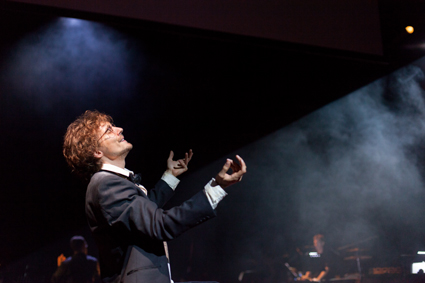The trouble with tragedy
Keith Gallasch
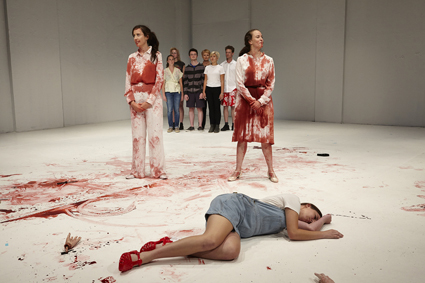
post, Oedipus Schmoedipus
photo Ellis Parrinder
post, Oedipus Schmoedipus
“The trouble with tragedy is the fuss it makes
About life and death and other tupenny aches”
Samuel Beckett
post, Oedipus Schmoedipus
For several Sydney reviewers post’s Oedipus Schmoedipus was their worst night in the theatre, or already the worst production of 2014. This wasn’t the majority view but the show did generate a modicum of public discussion. For me it raised issues about the changing relationship between theatre, contemporary performance and live art. Affectively, the show moved me from giggling at sense-making nonsense to sadly reflecting on the vulnerability we shared with each courageous volunteer performer.
In recent years the STC, Malthouse, Belvoir, Le Boite and MTC (the latter two featuring well-received seasons of independent works in 2014) have begun to address the changes that theatre is going through as the notion of what constitutes performance broadens. Some of that mainstream embrace was prompted by the encouragement of special funding from the Australia Council for large companies to take on emerging artists and companies several years ago. In the meantime contemporary performance has been expanding into live art, game-playing theatre, one-on-one and participatory performances and combinations thereof. Sydney Festival featured My Darling Patricia’s The Piper and post’s Oedipus Schmoedipus, both of which invited the public to perform in their productions.
Post’s participants, a different bunch of 25 people each night over many nights, were trained up early on the day of performance for three hours on where to move, costume choices and how to follow their cues from video monitors hanging above the audience. The participants performed admirably, hamming it up, singing, dancing, ‘dying,’ looked happy and generally from those we spoke to loved the experience, although they had to miss seeing the controversial, bloodletting opening in which Mish Grigor and Zoe Coombes Marr, in white, murder each other or suicide over and over, invoking the blood-letting legacy of thousands of years of male writing. One reviewer labelled the volunteer participants “meat puppets.” However, My Darling Partricia’s The Piper was not condemned for similarly manipulating its volunteers—children and accompanying adults responding to instructions coming through earphones.
While not as taut as Who’s the Best (STC, RT104) or mind-bendingly delirious as Everything I Know About the Global Financial Crisis in One Hour (Belvoir Downstairs, RT101)—the strings of word association were variable in quality and overlong—Oedipus Schmoedipus was a delight. The quiet charisma of the two performers, the relentless silly searching (“What is death?”: Every cliché imaginable!) and a growing sense of poignancy as we grew to know the faces and bodies of the volunteers made the work a memorable exemplar of the incursion of new practices into the mainstream.
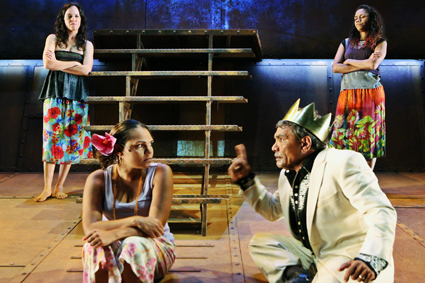
The Shadow King
photo Prudence Upton
The Shadow King
Malthouse, The Shadow King
The Tragedy of King Lear is not short on laughs either; Malthouse’s version of Shakespeare’s play is full of them, but with the same ironic, mocking and often bitter intent, if here self-deprecating as well, portraying an Aboriginal community turned against itself.
The Shadow King (creators Michael Kantor, Tom E Lewis) is a melodramatic transposition of Shakespeare’s pre-mediaeval setting to an Indigenous community fighting over the exploitation of mineral wealth on Aboriginal land. These are modern people but their lives are still imbued, if in varying degrees, with spiritual attachment to the land. One of them, the embittered bastard Edmund (Jimi Bana), is bereft of these feelings and intent on destroying the culture that stands in the way of acquiring the land for himself—using his charm, sex and violence. When he plays demanding, panicky little boy to his mother, you’re not sure if his cunning or insecurity is on show.
In this scenario, the character Kent has been replaced by Edmund’s mother (Frances Djulibing), a clever move which recognises the role of female elders in Indigenous life. When Edmund, with Goneril [Jada Alberts] and Regan [Natasha Wanganeen] capture Lear and the mother, they discard her dilly bag, the reticule of sacred objects and knowledge. Appropriately it lies on red sand of the forestage next to Lear’s abandoned crown.
Despite the simplifying of Shakespeare’s plot and the intricacies of his characterisations, this version manages to retain a lot of its weight, partly because we know it so well, partly because The Shadow King fascinatingly blends Shakespeare’s poetry with Aboriginal English and the cadences of un-surtitled Aboriginal languages, conveying some of the otherness of the classic and making modern sense of Shakespeare’s essential wordplay. The adaptation also deftly contextualises the transposition: Goneril’s husband is in gaol, there is violence in town and a young girl murdered—for which Edmund frames Edgar. The latter appears disguised in full ceremonial attire, although its veracity cannot be guaranteed: a delirious Lear utters, “He’s the real thing!”
This production is cartoony, melodramatic, showbizzy (replete with songs) and forcefully projected (resulting in degrees of unintelligibility despite the head mikes). Tom E Lewis as Lear first appears in white suit, black cowboy shirt and golden crown, playing straight to the audience like a club entertainer, charming, volatile, his anger really felt, the cracks in his composure rapidly widening, his movements increasingly manic.
The daunting set (Paul Jackson, Michael Kantor, David Miller), swivelling slowly and rumbling towards us on tracks, suggests the base of an enormous mining crane. With the lowering of a metal wall-cum-screen to its top, film projections evoke humble homes and backyards, the night-time bush road on which the mad Lear is pursued by headlights, the vast landscapes of disputed land and the massive cliff on which Edmund and Edgar’s mother thinks she is standing, expecting to step to her death.
Rarriwuy Hick is a strong Cordelia, too briefly seen. Drag performer Kamahi Djordon King (See RT113) is a fine youthful Fool, delivering old and new witticisms and insults with verve as well as transforming himself into hilarious versions of Regan and Goneril in the mock trial which Lear conducts. Lewis is wonderfully affecting when, with flowers in his hair, he recognises his failings. Frances Djulibing’s Mother with her quiet physical presence and low-key delivery offers a telling counterpoint to Lear’s mania. And she sings sublimely. As does Djakpurra Munyarryun whose haunting voice comes to the fore in the production’s moving climax.
Although Shadow King is Lear condensed, ramped up and located very specifically in 21st century Australia (going further than most transpositions of classics) it retains its primal power while firmly reminding us that Aboriginal Australians are indeed “Shadow Kings,” at risk of having their land taken from them by their own kin or an ever encroaching mining industry and opportunistic politicians. “Tragedy” in Shadow King is personal, familial and above all cultural.
Mitchell Riley, His Music Burns, Sydney Chamber Opera
photo Louis Dillon-Savage
Mitchell Riley, His Music Burns, Sydney Chamber Opera
Sydney Chamber Opera, His Music Burns
“Tragedy” these days is so broad a notion that its meaning has become much diminished, simply focusing on the loss of life and of potential: the younger the victims the more tragic. The notion has also had to cope with 20th century Existentialisms: either all life is tragic (no God, no afterlife, we’re all cut short) or is not at all tragic—face up to that and you’ll live authentically.
The Sydney Chamber Opera double bill of Gyorgy Kurtag’s …pas a pas – nulle part (1993-98) and George Benjamin’s Into the Little Hill was one of the most satisfying events in the 2014 Sydney Festival. Before witnessing the cruelty in Benjamin’s take on the Pied Piper we were faced with existential anxieties and their wickedly funny repudiations of the kind only Samuel Beckett can conjure and Kurtag make musical.
Simply but highly effectively staged (designer Katren Wood) with rows of empty seats, Sarah Giles’ direction of the Kurtag places us face to face with a lone, tall, angular young man seated in an auditorium. Here, in 29 brief scenes in which he endures a great range of emotions, he sings poems penned by Samuel Beckett in 1937-39 and others translated by the writer. Giles has wrought a thoroughly convincing performance from baritone Mitchell Riley as he stares, grimaces, falls asleep, ponders, gives up and bounces back with comic verve and sung lines that wax lyrical, angst and leap into falsetto. He’s partnered by percussion and strings, the percussion played solo (Timothy Brigden) on a wide array of instruments providing the other principal voice in the work with its own reveries and shocking alarums underlining or counterpointing the singing. Moments of tedium alternate with despair in the face of death which can only be laughed about—which is apparently why Beckett wrote his poems, for the coping.
By setting the work in an auditorium that mirrors ours, turning the work’s silences into blackouts and having the text in super-sized surtitles, Giles adds another layer of anxiety, about the value or not of art. What does the young man make of us and our performance—our watching him? Does our own visit to the theatre likewise include moments of not being there, of nodding off (“sleep till death/ healeth/ come ease/ this life disease”) and being jolted awake by tragedy and “the fuss it makes.”
For Benjamin’s Into the Little Hill the setting is the same, but long shafts of lighting (Matt Cox) transform it into sequential spaces in which the two singers, one as the Pied Piper (Ellen Winhall) and the other as the Mayor (Emily Edmonds) narrate their story—in a style distinctively the librettist’s, English playwright Martin Crimp—as an eerie dialogue. Again art and death meet: the Piper declares his power: “With music I can make death stop.” Of course the opposite is also true, “his music burns.” The Mayor, for his treachery must lose his own child, who will become but an apparition on the hill where the Piper has taken him. Moreover, the Crimp-Benjamin version of the tale suggests that the ‘rats’ are a rejected and doomed human minority: a mysterious tale for children becomes allegorical for adults and a tragedy of another kind. As the interplay between singers proceeds this world is transformed by betrayal and loss, the chairs rearranged, stacked, put away, the world/the theatre closed.
The singing by Winhall and Edmonds is extraordinary, the demands of range, key shifts and dramatic needs well met and theatrically right. The physiognomy of Winhall’s Piper transforms eerily as the lighting re-sculpts her and her voice, ever lucid, climbs higher and higher, or growls in a warning lower register. The Mayor’s devious air of reasonableness and then her dawning panic is firmly realised by Edmonds. As ever, Jack Symonds conducts with exactitude and passion, has coached his singers brilliantly and collaborated finely with Sarah Giles. If ever a production warranted a return season, this is it. The large audiences were rapt.
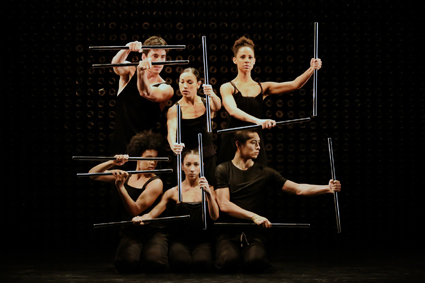
Am I, Shaun Parker & Dancers
photo Prudence Upton
Am I, Shaun Parker & Dancers
Shaun Parker & Dancers, Am I
I enjoyed Shaun Parker’s Am I—the taut, often gestural ensemble choreography, the singular use of light and the boldness of tackling very big ideas neatly laid out for us. But the ideas were worrying, the show’s text adapted from Rick Hanson and Richard Mendius’ Buddha’s Brain: The Practical Neuroscience of Happiness, Love and Wisdom (2009) with additional material from Am I’s dramaturg Veronica Neave. If the book’s title suggests a scientific confirmation of the good things about life, the show does not.
The absence of question mark in the title is odd, but the work consistently states that the answer is already a given. We are stardust: we come from nothing on our way to nothingness with little consolation in between. The performance, in which our creation, evolution and passing is narrated and danced, is initially contemplative—our host, Indian guest artist Shantala Shivalingappa, introduces us to the nothingness of our origins and sings sublimely, evoking Eastern cultures’ meditative inclinations.
But the greater part of Am I is not at all contemplative. It is beautiful to witness: on a large wall tightly ordered light bulbs flicker, pulse and pattern, momentarily blinding us with the Big Bang (as the narrator utters: “nothing prepares to become something”), evoking the sun and the stars, framing our evolution and abandoning us to the fading light of entropy (designer Damien Cooper). The highly structured dancing, much of it focused on hands and arms, traces our manual capacity to make and invent. Four dancers in black form a tight cluster; the wall behind glows benignly. A furious dance of arms and hands rapidly forms abstract and then more literal shapes: fingers, like tiny humans, walk along arms; the wings of a large bird take flight; hands form an intricate, living totemic column. Such magical mimcry is a consolation of art. It celebrates observation, skill and especially cooperation.
But Parker is not going to let us off the existential hook: cooperation, although in ample evidence in Am I’s very creation, is not finally worthy of celebration. The dancers now wield metre-long chrome rods, limb-extending tools that engender new cooperative creations, this time tautly geometric. These however become murderous weapons, not least in the hands of a dominant, twirling warrior figure (Julian Wong), despite the narrator’s claim that our reptilian brain functions for survival more by “avoidance than approach.” In this world sexual coupling is a passionless, comical imposition, love is the product of a brain chemical, God has many names including Tweeting, without which “men are truly lost.” Josh Mu’s raw solo supplication to a non-existent God is a highlight, contrasting with the tight regimentation of the body elsewhere.
The final group dance is watched by the narrator from one side and by the warrior (like a Neitzschean Overman, challenged but never defeated) on the other as if the pair represent Knowledge and Power observing the raw dance of humans to African-like percussion in a reminder of our origins. The movement is harmonious if furious, upbeat if unsmiling and visibly exhausting—the dance of those living only in the moment? In her final declaration, the narrator offers us a passive view of ourselves, “I am nothing but a listener, everybody is one,” while a melancholy violin sings, atypically Western in the score and oddly sentimental given the hard lesson Am I is teaching us. There is no smiling Buddha in Am I.
By the end and despite its physical and visual magic, I felt Am I short on mystery and openness: a closed book in which culture is mechanical and deterministic. The emotional upside to the work is the music by Nick Wales, performed by the composer with a small group of artists atop the box that contains Am I’s lighting cosmos. Ranging stylistically and with considerable interplay from Armenian to Indian and other forms, the music offers transcendence, connoting passion, contemplation, pain and joy. We don’t know the meaning of the words sung or the sounds played, only that a creative mind has offered a spirited counterpoint to Parker’s dark view of human evolution in an unresponsive universe. Tragedy has no place in Am I, nor in Beckett. But Beckett laughs.
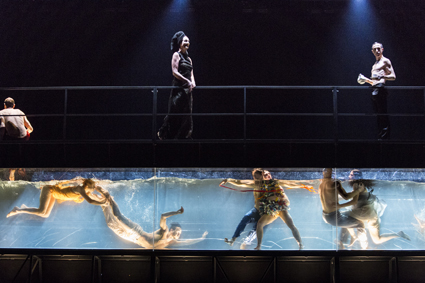
Dido & Aeneas, Sasha Waltz and Company
photo Jamie Williams
Dido & Aeneas, Sasha Waltz and Company
Other productions
I watched Sasha Waltz and Company’s Dido and Aeneas with interest rather than excitement, admired the fluent movement in the relatively brief if magical underwater scene, relished the singing, thought the orchestra excellent if sounding a shade mellow and enjoyed moments of the dancing with its clear inheritance from Pina Bausch, both in limpid solo turns and deft crowd management but lacking Bausch’s incisive dramatic sensibility and her capacity to generate spare, enduring images. My Darling Patricia’s The Piper overflowed with unregulated invention, making for an overly complex rendering of a simple tale. Ghenoa Gela’s performance as the Bear/Piper, the work’s puppetry and its audience participation made the production attractive but not as strong as it should be.
The Sydney Festival serves many audiences and programs many productions. Of the other shows I saw I particularly enjoyed the superb Hilliard Ensemble, Mike Patton with Ensemble Offspring in a magnificent performance of Berio’s Laborintus II and Tyondai Braxton’s immersive The Hive (see Gail Priest’s report on MONA FOMA). Marrugeku’s Gudirr Gudirr was an inevitable success after its winning appearance in 2013’s Dance Massive (RT114). FUNPARK by Karen Therese and the Bidwill Community in Sydney’s West revealed a maligned community’s capacity to assert its dignity through art. Overall I had a good festival experience, a thoughtful one with welcome moments of transcendence.
I’ve reviewed QTC’s Black Diggers alongside Ilbijerri’s Coranderrk and the STC/ADF’s the Long Way Home here. Unfortunately our other festival reviewer fell ill so we have no reviews of the Ondak installation at Parramatta, The Human Voice or All Fall Down (but see RT120 for its World Theatre Festival appearance in Brisbane).
You’ll find reviews of The Piper, The Hilliard Ensemble, Lee Ranaldo, Mike Patton with Ensemble Offspring in my second festival report online.
2014 Sydney Festival, Jan 9-26
See Sydney Festival 2014 Part 2
RealTime issue #119 Feb-March 2014 pg. 16-17


